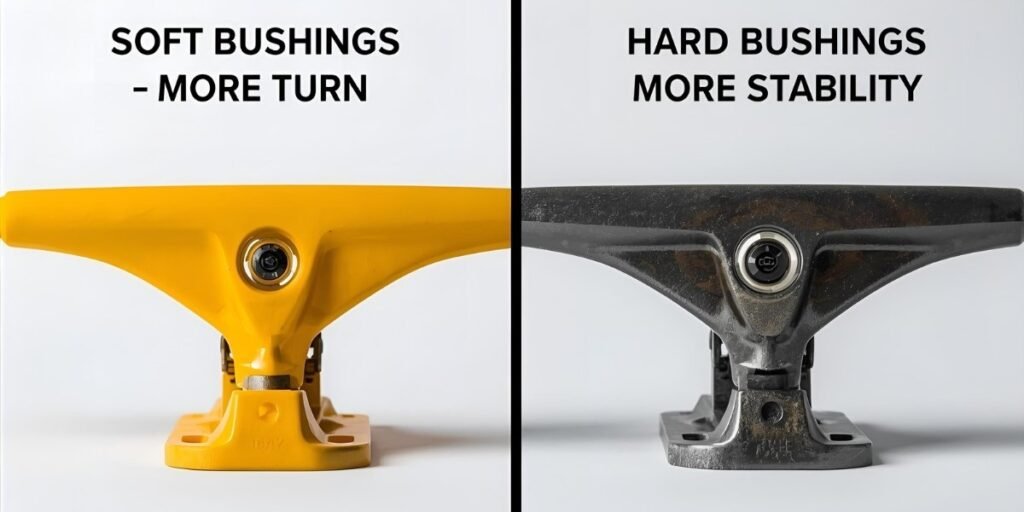What if I told you the most important part of your skateboard costs less than a cup of coffee? It’s not your deck, wheels, or bearings. It’s your bushings.
These two small and colorful rings in your trucks are the secret to everything. They control how you turn, how stable you feel at high speeds, and the board’s overall personality. If your skateboard feels “off,” this is the first place you should look. Get ready, because we’re about to break down everything you need to know to change your ride for the better completely.
What Are Bushings on a Skateboard?
Bushings are small urethane cushions placed around the kingpin inside each truck. Each skateboard truck has two bushings: one on the top (near the kingpin nut) and one on the bottom (closer to the hanger).
When you lean on your board, the bushings compress, allowing the trucks to pivot. This compression and rebound are what make your skateboard turn. Without bushings, trucks would feel stiff and unresponsive.
Even though they’re small, bushings influence stability, turning radius, and how much control you have. Think of them as the suspension system of your skateboard.
How Do Skateboard Bushings Work?
The mechanics are pretty simple but have a huge effect on your ride.
When you lean left or right on your deck, you are putting pressure on your trucks. This pressure compresses the bushings, allowing the truck’s hanger to pivot around the kingpin. This pivot is what makes your board turn.
The key properties of the bushing (its hardness and shape) determine how much it resists this pressure.
In short, bushings work by compressing to allow turns and rebounding to bring you back to center.
Types of Skateboard Bushings
Bushings come in different shapes and durometers (hardness levels). Each shape changes how your trucks feel under pressure.

Cone Bushings
Cone bushings taper towards the edge, offering less resistance. They provide quick turns, smooth carves, and a surfy feel. Many street skaters and cruisers prefer them for easy maneuverability.
Barrel Bushings
Barrel bushings are thicker and uniform in shape. They offer more resistance and stability compared to cones. Downhill skaters and riders who need control at high speed often choose barrels.
Double Cone
Using two cone bushings in one truck maximizes maneuverability. This setup is great for carving, slalom, and freestyle, where responsiveness matters more than stability.
Double Barrel
With two barrels in one truck, you get maximum stability. This setup suits downhill, freeride, and riders who want to minimize wobble.
Stepped or Eliminator Bushings
Stepped bushings combine flat edges and a wider base, giving strong resistance while still allowing turns. They’re common in high-speed setups where stability is critical.
Skateboard Bushings: Hard vs Soft

One of the most significant decisions when selecting bushings is whether to opt for hard or soft options. This is measured by durometer, usually on the Shore A scale.
- Soft Bushings (78A – 88A): Softer bushings compress easily. They give deeper turns, quick response, and are great for lighter riders or those who enjoy carving. But at high speed, they may feel unstable.
- Medium Bushings (90A – 96A): These strike a balance. They’re versatile enough for both street and park skating. Most skaters fall into this range since it offers both control and maneuverability.
- Hard Bushings (97A+): Harder bushings resist compression. They’re stable at high speed, great for heavier riders, and perfect for downhill or transition skating. The trade-off is fewer turns and maneuverability.
Your body weight also matters. A 120-pound skater on hard bushings might struggle to turn, while a 200-pound skater on soft bushings could feel too loose.
How Do I Choose the Right Skateboard Bushings?
Choosing bushings comes down to three main factors: weight, riding style, and preference.
- Weight: Heavier skaters often need harder bushings to avoid wheel bite and instability. Lighter skaters usually feel more comfortable on softer ones.
- Riding Style: Street and technical skaters prefer medium bushings for versatility. Cruisers and carving riders lean toward soft bushings. Downhill and freeride skaters rely on hard bushings for stability.
- Preference: Some skaters like a loose, surf-like ride, while others want tight control. Experimenting with setups is the best way to find what feels natural.
If you’re unsure, start with stock bushings (usually medium) and adjust from there.
Skateboard Bushings Chart
Here’s a weight-to-durometer chart to help you pick the right hardness:
| Rider Weight | Recommended Durometer | Best Use Case |
| Under 100 lbs (45 kg) | 78A–85A | Cruising, carving, beginners |
| 100–150 lbs (45–68 kg) | 85A–90A | Street, light all-around use |
| 150–200 lbs (68–90 kg) | 90A–95A | Street, park, vert |
| 200+ lbs (90+ kg) | 95A–100A | Downhill, speed, stability |
Which Skateboard Bushings Are Best?
The “best” bushings are the ones that are best for you. After using the chart to find your hardness, think about your style:
- For Cruising & Carving: You want lots of turns. Try a soft durometer with a cone/barrel or even a double cone setup for a super surfy feel.
- For Street & Park: You need a balance. A medium durometer with the classic cone/barrel setup is perfect. It lets you turn but is stable enough for landing tricks.
- For Downhill & Speed: Stability is everything. Use a hard durometer with a double-barrel setup to eliminate wobbles at high speed.
Bushings are a cheap investment that can completely change how your board feels. Don’t be afraid to experiment with different hardness levels and shapes to find what feels best for your ride.
When to Replace Your Bushings
Bushings don’t last forever. Signs you need new ones:
- Cracks or splits in the urethane.
- Flat spots or squished shape.
- Squeaky trucks (sometimes pivot cup, but worn bushings squeak too).
- Sluggish turns—the board doesn’t snap back like before.
Most bushings last a long time with normal street skating. Downhill or heavy riders may replace them more often.
How to Install and Adjust Your Bushings
You don’t need to be a gear expert to swap your bushings. All it takes is a skate tool.
- Use your tool to unscrew the large kingpin nut.
- Remove the top washer and the top bushing.
- Lift the truck’s hanger off the pivot cup.
- Remove the bottom bushing and washer.
- Put everything back in reverse order with your new bushings.
Do NOT overtighten your kingpin nut! Cranking the nut down to make your trucks stiffer will destroy your new bushings and make them feel dead. The nut should only be tight enough so the bushings are snug and the washers don’t jiggle. If you want a stiffer ride, buy harder bushings.
Final Thoughts
Bushings may be small, but they define how your skateboard feels. From soft cone bushings for smooth carves to hard barrels for downhill stability, there’s a setup for every style.
If you’re a beginner, go for a medium cone + barrel setup. Because it’s versatile and easy to ride. As you progress, experiment with different shapes and hardness levels to find your perfect match.
Bushings are like the personality of your board; pick the right ones, and your skateboard will feel alive under your feet.
FAQs
How do I know what bushings I need?
The right bushings depend on your weight and riding style. Lighter riders and cruisers usually prefer softer bushings (78A–90A). Heavier riders or skaters who need stability go with harder ones (90A–100A). If you’re not sure, a medium setup (90A–95A cone + barrel) works for most skaters.
Do bushings affect tricks?
They don’t directly change your pop, but they affect control. Loose bushings make flips and manuals feel easier to adjust, but they can feel unstable on landings. Harder bushings give more balance for big tricks and vert skating.
How long do skateboard bushings last?
Bushings can last months or even years. Generally, it depends on how you skate. Street and park skaters usually don’t wear them out fast. Downhill riders, heavy skaters, or anyone riding loose trucks may need replacements more often.
Do I need washers for bushings?
Most setups use washers to keep bushings from wearing out too fast. Cupped washers add control and stability. On the other hand, flat washers allow freer movement. Some skaters ride without them, but that can shorten bushing life.
What’s the difference between barrel and cone bushings?
Cone bushings allow more turning and are usually used for cruising or carving. Barrel bushings provide more resistance and stability, making them ideal for high-speed or technical skating. Some skaters combine them for a balance of stability and turn.
Should I get soft or hard bushings?
Soft bushings are best for lighter riders, carving, and easy turns. Hard bushings suit heavier skaters, tricks, and high-speed stability.

